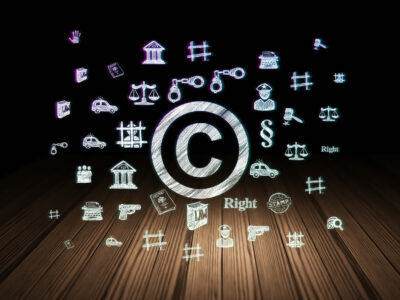“If an original work and secondary use share the same or highly similar purposes, and the secondary use is commercial, the first fair use factor is likely to weigh against fair use, absent some other justification for copying.” – Supreme Court in Warhol v. Goldsmith
 Copyright exits everywhere—from books on a library shelf to music playing on the radio, to the software running the electronic device on which you are reading this article. Copyright’s broad scope and extensive reach foster a varied and fascinating landscape of copyright cases. From cases involving the use of a celebrity photograph, animated dancing video game characters, to artificial intelligence (AI) infringement inquiries, the number and type of matters copyright touches is seemingly infinite. This provides an evergreen bounty of copyright cases to digest. The following highlights some of the top copyright decisions of 2023.
Copyright exits everywhere—from books on a library shelf to music playing on the radio, to the software running the electronic device on which you are reading this article. Copyright’s broad scope and extensive reach foster a varied and fascinating landscape of copyright cases. From cases involving the use of a celebrity photograph, animated dancing video game characters, to artificial intelligence (AI) infringement inquiries, the number and type of matters copyright touches is seemingly infinite. This provides an evergreen bounty of copyright cases to digest. The following highlights some of the top copyright decisions of 2023.
Supreme Court Cases
Andy Warhol Foundation for The Visual Arts, Inc. v. Goldsmith et al.
In Andy Warhol Foundation for The Visual Arts, Inc. v. Goldsmith et al., the United States Supreme Court ruled on May 18, 2023, that Andy Warhol Foundation for the Visual Art’s (“AWF’s”) licensing of a Warhol-created illustration of a photograph of Prince to a magazine was not a fair use of the underlying Goldsmith-created photograph of Prince.
The Supreme Court focused on the first fair use factor and held that the “purpose and character” of AWF’s use weighed against fair use. The Court emphasized that because most copying inherently has some further purpose and many secondary works add something new, the first factor does not ask whether the copying use transformed the underlying work at all, but rather “whether and to what extent” the use at issue has a purpose or character different from the original.
AWF argued that the Warhol illustration added a new expression to the underlying Goldsmith photograph and was thus transformative. The Court, however, focused on the commercial licensing of the Warhol illustration for use in a magazine. Focusing on that use, the Court held that the commercial licensing of the Warhol illustration for use in a magazine served substantially the same purpose as the Goldsmith photograph – a portrait of Prince used in a magazine to illustrate stories about Prince. The Court explained, “if an original work and secondary use share the same or highly similar purposes, and the secondary use is commercial, the first fair use factor is likely to weigh against fair use, absent some other justification for copying.”
Importantly, the Court emphasized that the fair use analysis is fact and context dependent. Indeed, one of the key takeaways from this decision is that the Court narrowly focused its analysis on the specific use (commercial licensing to a magazine) and did not evaluate the creation of the artwork or any other use of the artwork, and instead emphasized the need to conduct the fair use analyses based on the specific facts of each particular use, stating “the difference must be evaluated in the context of the specific use at issue.”
Warner Chappell Music, Inc. v. Nealy – Eleventh Circuit Decision and Certiorari Granted
On September 29, 2023, the Supreme Court granted certiorari in Warner Chappell Music, Inc. v. Nealy, to consider whether, under the discovery accrual rule applied by the circuit courts and the Copyright Act’s statute of limitations for a civil action, a copyright plaintiff may recover damages for acts that allegedly occurred more than three years before the filing of a lawsuit.
There is a circuit split regarding whether a plaintiff may recover for infringement that occurred more than three years before the filing of an otherwise timely claim under the discovery accrual rule. The Second Circuit has held that even if timely filed under the discovery rule, a plaintiff may not recover for infringement that occurred more than three years before the plaintiff filed suit, while the Ninth Circuit has held that a plaintiff can recover for infringement that occurred more than three years prior to filing suit if otherwise timely under the discovery rule. In Warner v. Nealy, the Eleventh Circuit agreed with the Ninth Circuit, furthering the split.
The Circuits disagree on the interpretation of the 2014 Supreme Court case Petrella v. MGM where the Court stated that one of the reasons it was unnecessary to apply the doctrine of laches to copyright claims was that “Section 507(b) . . . bars relief of any kind for conduct occurring prior to the three-year limitations period” and that retrospective relief is available to a copyright plaintiff “running only three years back from the date the complaint was filed.”
In Nealy, the Eleventh Circuit held that a copyright plaintiff may recover retrospective relief for infringement occurring more than three years before filing suit if the suit is otherwise timely under the discovery rule. The Eleventh Circuit opined that Petrella was directed to the application of the statute of limitations when the injury rule applies, but not the discovery rule, and that the text of the Copyright Act does not place a time limit on remedies for an otherwise timely claim.
Petitioners Warner Chappell Music, Inc. et al. filed their brief in November 2023 and respondents’ brief will be filed in January 2024, with a decision expected later in 2024.
Artificial Intelligence
Copyright Ownership: In 2023, both the Copyright Office and a district court weighed in on the copyrightability and ownership of the products of generative AI.
In August 2023, the D.C. District Court affirmed the Copyright Office decision that a work created by a generative AI tool called DABUS was not copyrightable. Thaler v. Perlmutter, et. al., No. 1:22-cv-01564-BAH (D. D.C.). The court explained, “human creativity is the sine qua non at the core of copyrightability, even as that human creativity is channeled through new tools or into new media.” The court elucidated that unlike traditionally accepted tools like cameras, which merely generate a “mechanical reproduction” of a scene after the photographer has already developed a “mental conception” of how the photograph will look, generative-AI tools stretch US copyright law beyond its limits as such technologies “operate[] absent any guiding human hand, as plaintiff urges here.” The court noted that though “author” was left undefined by the Copyright Act, dictionary definitions for the term center on “an originator with the capacity for intellectual, creative, or artistic labor” and determined that “the originator [must] be a human being to claim copyright protection.” Further, the court found support in the Copyright Act of 1909, which was “unambiguously limited to the works of human creators” and prior court decisions that have “uniformly declined to recognize copyright in works created absent any human involvement, even when, for example, the claimed author was divine.”
The Thaler court conceded that “we are approaching new frontiers in copyright as artists put AI in their toolbox to be used in the generation of new visual and other artistic works” but opined that Thaler’s application was properly denied given that the “[Thaler] played no role in using the AI to generate the work, which [Thaler] never attempted to correct.”
Mr. Thaler has filed a notice of appeal to the D.C. Circuit, with briefing expected in 2024.
AI Infringement Cases: Several cases were commenced in 2023 surrounding alleged copyright infringement by the developers of generative AI programs. The plaintiffs in these cases have made various claims, including Digital Millennium Copyright Act (DMCA) violations, unfair competition, and right of publicity claims. As to copyright infringement, they generally allege both direct copyright infringement (i.e., they claim that the copying of their works for training is an infringement; that the AI model itself is an infringing derivative work; and that generated output is substantially similar to their works) and indirect copyright infringement (i.e., that the AI programs provide the means for users to create infringing works).
Images Cases
Andersen and Getty Images
In January 2023, artists Sarah Andersen, Kelly McKernan, and Karla Ortiz, along with a proposed class of “at least thousands” of other artists, filed a class action complaint alleging direct and vicarious copyright infringement, DMCA violations and right of publicity violations, and unfair competition based on the creation and functionality of Stability AI’s Stable Diffusion and DreamStudio, Midjourney Inc.’s generative AI tool, and DeviantArt’s DreamUp. Andersen v. Stability AI, et al., No. 3:23-cv-00201 (N.D. Cal.). All defendants in this case provide tools and services that leverage generative AI to create images based on text prompts from users, which plaintiffs allege were trained on data sets that scraped over five billion images from the internet for Stability AI’s development of Stable Diffusion.
The defendants filed separate motions to dismiss, and DeviantArt filed a separate anti-SLAPP motion to strike the right of publicity claims, in which both Midjourney and Stability AI joined. On October 30, 2023, the district court issued an order dismissing the copyright claims where there was no valid copyright registration prior to filing suit, dismissing with prejudice the claims for unfair competition as preempted by the U.S. Copyright Act, and dismissing with leave to amend as to all other claims, but warned “I will not be as generous with leave to amend on the next, expected rounds of motions to dismiss and I will expect a greater level of specificity as to each claim alleged and the conduct of each defendant in support of each claim.”
In February 2023, Getty Images (US) filed suit against Stability AI, accusing Stability AI of infringing more than 12 million photographs, their associated captions and metadata, in building and offering Stable Diffusion and DreamStudio, along with other claims related to the generative output that included Getty Images watermarks. Getty Images (US), Inc. v. Stability AI, Inc., et. al., No. 1:23-cv-00135-UNA (D. Del.). To date, no substantive issues have been decided as defendants moved to dismiss for personal jurisdiction and forum grounds and the parties remain engaged in jurisdictional discovery.
Author Cases
Tremblay, Silverman, Chabon, Kadrey, Authors’ Guild
In 2023, a series of class-action lawsuits were filed against OpenAI (amongst other codefendants) in the Northern District of California by Paul Tremblay (Tremblay, et al. v. OpenAI Inc., et. al., N.D. Cal. 3:23-cv-00201), Sarah Silverman (Silverman, et al. v. OpenAI Inc., et. al., N.D. Cal. 3:23-cv-03416), and Michael Chabon (Chabon, et al. v. OpenAI Inc., et. al., N.D. Cal. 3:23-cv-04625). In each action, the classes of plaintiffs claim that the content of their copyrighted books were allegedly ingested and used to train OpenAI Inc.’s ChatGPT and other codefendant’s AI products. Each case also claims the output itself can be allegedly infringing. In Chabon, for example, the complaint alleges that generative-AI has successfully been prompted to create a “detailed outline for a prequel book to A Game of Thrones … using the same characters from Martin’s existing books in the series A Song of Ice and Fire.” Each case asserts claims of direct and vicarious copyright infringement, DMCA violations for CMI removal, unfair competition, negligence, and unjust enrichment. On November 9, 2023, each of the cases were consolidated and the court explained that a consolidated complaint was to be filed within 30 days of the court’s ruling on the pending motions to dismiss in Tremblay and Silverman. In both cases, OpenAI had already filed motions to dismiss all counts for failure to state a claim, except the direct infringement claim against OpenAI.
Richard Kadrey, along with Sarah Silverman and Christopher Golden, filed a class-action suit against Meta Platforms, Inc., similarly alleging that the content of their copyrighted works was allegedly ingested and used to train Meta’s LLaMA language models. Meta moved to dismiss all claims other than the copyright infringement claim alleging that the unauthorized copying of the plaintiffs’ books for purposes of training LLaMA constitutes copyright infringement. On November 20, 2023, the Kadrey court granted Meta’s motion, dismissing with prejudice the claim of negligence and dismissing with leave to amend the claims (1) that the LLaMA models are infringing derivatives; (2) that the outputs of the LLaMA language models are infringing derivatives; (3) that there was a distribution of content without CMI; (4) that there was unfair competition; and (5) and that there was unjust enrichment. The court rejected plaintiffs’ contention that because their books were allegedly duplicated in full to train LLaMA the plaintiffs need not allege any similarity between LLaMA outputs and their books to maintain claims that there are infringing derivatives. Instead, and “[t]o the extent that [plaintiffs] are not contending LLaMA spits out actual copies of their protected works, they would need to prove that the outputs (or portions of the outputs) are similar enough to the plaintiffs’ books to be infringing derivative works.” As to plaintiffs’ DMCA claims, the court found there was no evidence LLaMA ever distributed the plaintiffs’ books, “much less did so ‘without their CMI.’” Plaintiffs’ remaining unfair competition, unjust enrichment, negligence, and breached duty of care claims were found to be preempted, as each claim relied upon the same rights contained in the Copyright Act. Plaintiffs will have an opportunity to file an amended complaint.
Another similar case was filed against OpenAI in the Southern District of New York by the Authors Guild (Authors Guild, et al. v. OpenAI Inc., et. al. S.D.N.Y. 3:23-cv-00201), in which the Authors Guild alleges that defendants copied plaintiffs’ works wholesale without permission or consideration. There, no motion practice has commenced, but it is expected in early 2024.
Music and Dance
Kathryn Griffin et al. v. Ed Sheeran et al.
On May 4, 2023, a federal jury in the United States District Court of the Southern District of New York returned a special verdict ruling in favor of defendant, Ed Sheeran, finding that he established by a preponderance of the evidence that he independently created the song “Thinking Out Loud” and thus did not infringe the copyright of Marvin Gaye’s “Let’s Get It On.” Many credit the jury’s determination to particularly effective testimony by Mr. Sheeran. There have been numerous complaints brought for similar allegations regarding use of similar basic chord progressions, arpeggios, etc. and whether infringement occurred from such use. Looking ahead, a key lesson learned from this case is that testimony from the accused artist is invaluable.
Hanagami v. Epic Games, Inc.
On November 1, 2023, the Ninth Circuit reversed and remanded the district court’s decision in Hanagami v. Epic Games, Inc., finding that Hanagami plausibly alleged that his choreography and Epic’s emotes shared substantial similarities. Hanagami, a well-known LA-based choreographer published a YouTube video of a five-minute dance performed to the song “How Long” by Charlie Puth. The dance contains around 480 counts of choreography, consisting of ninety-six counts repeated by five groups of dancers. The video has over 37 million views. Epic is the creator and developer of the online video game Fornite. Fornite players can purchase “emotes” for their characters. Emotes are virtual animated movements or dances that players can use to make their characters dance. Hanagami alleged four out of the 16 counts of movement that consist of the emote called It’s Complicated, were copied from Hanagami’s choreographic work, which Hanagami claimed is the most recognizable portion of his choreography.
The district court dismissed Hanagami’s claims for failure to state a claim, finding that the four counts of movement consisted of unprotectable individual poses, that Hanagami was only entitled to protection for the way the steps were expressed in his registered choreography as a whole (i.e., the entire five-minute video), and that the emote was not substantially similar to the five-minute video.
The Ninth Circuit reversed, stating that reducing choreography to “poses” is “fundamentally at odds with the way we analyze copyright claims for other art forms like musical compositions.” The Ninth Circuit discussed how, like other forms of copyrightable material, choreography is composed of various elements which, when viewed in isolation, are unprotectable, but noted that it is the selection and arrangement of the otherwise unprotectable elements that is protectable by copyright. Instead, it held, the creative elements of Hanagami’s choreography cannot be analyzed by static poses, but rather, exist in the footwork, movement of limbs, hand and fingers, head and shoulder movement all covered by his work. The Ninth Circuit further held that the district court erred by ruling that the steps in the four-count sequence were unprotectable because they are relatively brief, instead holding that Hanagami was required to allege that the four-count portion of the dance has substantial qualitative significance to the overall registered choreography. It emphasized that “copyrightable choreography and uncopyrightable dance exist on a continuum” stating that the four-count portion may fall somewhere in the middle, but highlighting that the question is not whether the four-count portion would be registrable on its own, but rather, whether Epic unlawfully appropriated the portion from the registered choreography. The case has been remanded to the district court.
More to Come
These key cases from 2023 have laid the groundwork for many more interesting and novel copyright decisions in 2024. Stay tuned!
Image Source: Deposit Photos
Author: maxkabakov
Image ID: 73850035

![[IPWatchdog Logo]](https://ipwatchdog.com/wp-content/themes/IPWatchdog%20-%202023/assets/images/temp/logo-small@2x.png)



![[Advertisement]](https://ipwatchdog.com/wp-content/uploads/2024/04/UnitedLex-May-2-2024-sidebar-700x500-1.jpg)
![[Advertisement]](https://ipwatchdog.com/wp-content/uploads/2024/04/Artificial-Intelligence-2024-REPLAY-sidebar-700x500-corrected.jpg)
![[Advertisement]](https://ipwatchdog.com/wp-content/uploads/2024/04/Patent-Litigation-Masters-2024-sidebar-700x500-1.jpg)

![[Advertisement]](https://ipwatchdog.com/wp-content/uploads/2021/12/WEBINAR-336-x-280-px.png)
![[Advertisement]](https://ipwatchdog.com/wp-content/uploads/2021/12/2021-Patent-Practice-on-Demand-recorded-Feb-2021-336-x-280.jpg)
![[Advertisement]](https://ipwatchdog.com/wp-content/uploads/2021/12/Ad-4-The-Invent-Patent-System™.png)






Join the Discussion
No comments yet.